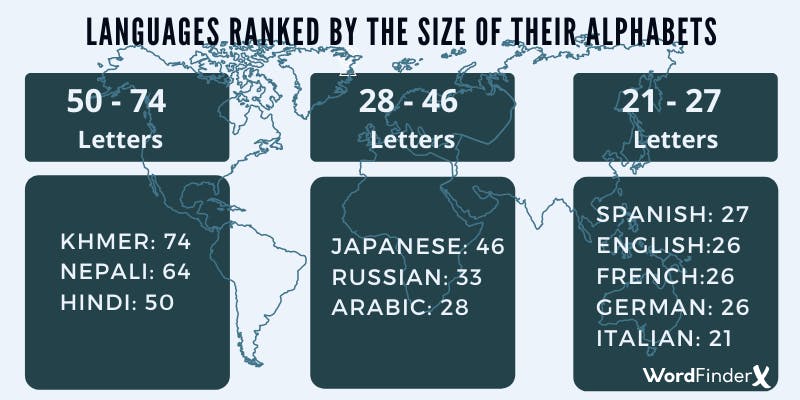Languages Ranked By The Size Of Their Alphabets

Introduction
Language is often the thing that defines cultures and countries the most. Whether you are speaking one of the world's biggest languages, like Spanish, English, or Mandarin, or a smaller, more isolated language like Basque, Chinook, or Romani, this form of communication is key to nearly every aspect of our lives. In this article, we’re going to take a look at those with the longest and most diverse alphabets.
How We Rank
According to Ethnologue.com, there are 7117 spoken languages around the world, and the job of measuring a languages alphabet is actually a little more complicated than it might seem. The first issue is how to count an alphabet. Take spanish for example; the vowels ‘A, E, I, O, U’ all exist in its alphabet, but they also all have accented forms. Do these count as additional characters within an alphabet, or are they simply variations on existing letters? For the purpose of this article, we are going to say just that. If a language includes a set list of letters in its alphabet, and doesn't count accented characters or combined variations, we will count it without them. We also won't be including languages such as Mandarin or Cantonese, where the term alphabet does not directly apply. These languages have ideographic writing systems, also known as pictographs, and do not fall exactly into the alphabet system for which we are going to count. With that said, let’s begin!Fun Fact
Mongolian has one of the longest word lengths, by letter, in the world, with an average of 13 letters per word!
Rank 1: Smaller Alphabets (21 - 26 Letters)
Most of you reading this will be familiar with some of the languages in this ranking. We are including these to give context to the size of languages in the future ranks. Let’s start with some popular European languages. English, has 26 letters based on Latin Script, as is German and French with 26 as well, and Spanish with 27. Italian has a surprising 21 letters in its alphabet, giving it the lowest in our first rank.
Fun Fact
Rotokas, an indegeounous language to Papua New Guinea is the smallest known language in the world with a total of 12 letters!
Rank 2: Larger Alphabets (28 - 46 Letters)
So as we move past some of the languages we’re used to, we start to find larger and more complex writing systems. Arabic for example, has 28 letters in its language, all of which are considered consonants, Arabic does of course have vowels, but they are instead shown by a ‘diacritical mark’ or glyph that is added to the existing letters. Then there is the Russian alphabet consisting of 33 letters. 10 of these are vowels, 21 are consonants and an additional two ‘signs’ or ‘modifiers’ also used to make words. Finally, in our second rank, we have Japanese. Now, it’s true that Japanese is an ideographic language, with Kanji being the most famous of it’s three writing systems, but unlike Chinese, Japanese has two phonetic alphabets, hiragana and katakana, which can both be counted in our rankings. Both languages have a total of 46 letters.
Fun Fact
The term ‘Digraphia’ refers to a language which has multiple writing systems. This is common around the world, particularly in India where Perso-Arabic script and Devanagari are often shown together on road signs.
Rank 3: The Biggest Alphabets (50 - 75 Letters)
Now we are in the upper echelon of alphabet lengths, and we start to break the 50 letters mark. Hindi, the most spoken language in all of India, has an alphabet consisting of 12 vowels, 33 consonants, and between 5 and 7 compound characters, giving it a total of between 50 and 52 letters (This number changes amongst different regions of India). Next up we have Nepali, a language that historically has grown out of a region with long and complex writing systems. Nepali has 64 letters in its alphabet, the largest we have talked about so far, but unfortunately, it doesn't take the top spot. That pleasure falls to Khmer. According to the Guinness Book Of World Records, the Khmer Language has the largest alphabet in the world, with a total of 74 letters, consisting of 33 consonants, 23 vowels and 12 independent vowels. Often referred to as Cambodian, Khmer is actually spoken in many countries in Southeast Asia, including Thailand, Vietnam, and some parts of Laos. The language has a total of 16 million native speakers.
Fun Fact
Khmer isn’t just the name of a language, it was a kingdom too! The Khmer Kingdom reigned over much of Southeast Asia between the years 802 to 1431.
Conclusion:
In this article, we’ve only dipped out toes into the world of alphabets, languages and the things that make them unique. With such a huge number of languages to explore, we encourage you to do your own research and educate yourself on the rich culture and history they can teach us.
Resources:
- Languages Around The World: Ethnologue
- Chinese & Cantonese Script: My Languages
- The Latin & Nepali Alphabet: Omniglot
- Hiragana & Katakana: Free Japanese Lessons
- Word Record Language: Guinness World Records

About the author
Casey Wise
Casey Wise is a British journalist, creative copywriter, and music creator with a deep passion for language, travel, and technology. Based in Barcelona, his work extends from local start-ups and newspapers to university radio and the British NHS.
